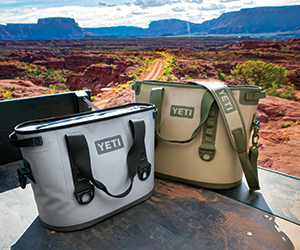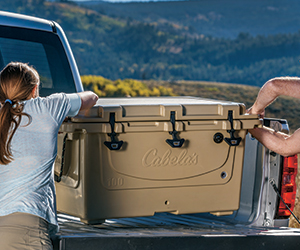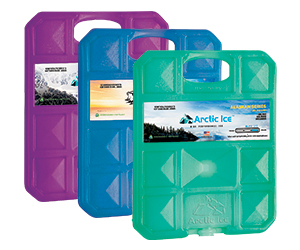
The Right Cooler Keeps Food & Drinks Cold For Days
The modern cooler looks and performs much differently than the most popular models from a decade ago. They keep contents colder for longer using efficient insulation and improved construction. If it’s been a while since you upgraded, it might be time to raise your expectations for cooler capabilities.
Coolers are essential for your outdoor adventures. There are plenty on the market to choose from. For simplicity, we’ll break down the buying decision into two questions: What type of cooler do I need and what size do I need?
What type of cooler do I need?
Soft-sided coolers
Ideal to cool beverages and food for one to four people without weighing you down. The functionality of soft-sided coolers used to be limited to just packing lunch for work, school and day trips. Traditional soft-sided models still do pack those lunches, but now you have the added option of modern “super” coolers that benefit from technologies that maximize thermal efficiency much more than any previous generation. Super coolers have exploded in popularity because of their extreme thermal efficiency and unbelievably rugged construction. Most of these super coolers are insulated with high-density foam. The higher the density, the higher the overall cooling efficiency. They have been tested to support claims that the coolers will keep ice for up to a specific number of days in certain conditions.
The functionality of soft-sided coolers used to be limited to just packing lunch for work, school and day trips. Traditional soft-sided models still do pack those lunches, but now you have the added option of modern “super” coolers that benefit from technologies that maximize thermal efficiency much more than any previous generation. Super coolers have exploded in popularity because of their extreme thermal efficiency and unbelievably rugged construction. Most of these super coolers are insulated with high-density foam. The higher the density, the higher the overall cooling efficiency. They have been tested to support claims that the coolers will keep ice for up to a specific number of days in certain conditions.
The lightweight, yet rugged construction of soft-sided coolers give them a distinct advantage over hard-sided models, which can be true back-breakers during transport. Soft-sided models make an easy choice if you’re packing for a family on a day trip or weekend retreat. If you need extra space, you step up into hard-sided cooler territory. Extra money in your soft-sided cooler budget buys you a super cooler model with thickly insulated walls and thermally efficient zippers for maximum cooling efficiency. Splurge on these premium coolers to keep food and drinks cold
for long periods in extreme heat and during extended getaways.
Hard-sided coolers
Used by outdoor enthusiasts who want near-indestructible durability and the most efficient cooling properties. In recent years, hard-sided coolers have improved through advancements in insulation and freezer-grade lid gaskets. These super coolers are the preferred option for avid outdoor enthusiasts who want the very best combination of size, ice retention and durability. Because of their heavy-gauge construction, super coolers weigh more than traditional coolers. A large, fully loaded model can be difficult to transport. Consider coolers with oversized handles and built-in wheels or a separate cooler cart to take the burden out of hauling them from home to field and back again.
In recent years, hard-sided coolers have improved through advancements in insulation and freezer-grade lid gaskets. These super coolers are the preferred option for avid outdoor enthusiasts who want the very best combination of size, ice retention and durability. Because of their heavy-gauge construction, super coolers weigh more than traditional coolers. A large, fully loaded model can be difficult to transport. Consider coolers with oversized handles and built-in wheels or a separate cooler cart to take the burden out of hauling them from home to field and back again.
In addition to plastic, hard-sided coolers are also available in metal. They appease customers who like sleek looks and traditional heirloom-type quality. Metal does absorb and retain heat longer than plastic. If you leave a metal cooler in the sun, the metal will warm up and retain sun exposure long after you move it to a shaded location. This is one of the reasons for the popularity of plastic in cooler construction.
If you decide to go with a hard-sided cooler, check if it has an insulated lid and seals tightly when closed. Most cooling is lost through the lid. Models skimping on such features will not compete with models that do. Another beneficial feature found on most coolers is a drain plug to quickly empty melted ice. Premium super cooler models often include bear-resistant latching systems and elevated nonskid feet.
Electric coolers
Intended use - Those who have access to a power supply and want to eliminate the inconvenience of using ice or ice packs to keep things cool.
An electric cooler, such as a midsized 12-volt model, is ideal for situations where your vehicle will power the cooler to keep food and beverages chilled on long drives. Most 12-volt coolers also can be converted to work in an ordinary 110-volt AC wall socket like those in a cabin or lodge. The obvious drawback with this type of cooler is that once the power is cut off, so is the cooling capacity. How long an electric cooler keeps its contents cool when not connected to a power source depends on conditions such as the ambient temperature, how full the cooler is and how often you open the lid. Electric coolers are well-insulated and should keep their contents cool for a few hours in the absence of electricity, but it depends greatly on the ambient temperature.
The temperature on most electric coolers cannot be set to an exact number. Instead, most say they cool to 40°F below the ambient temperature. This means that if you keep the cooler in a 75°F air-conditioned house, the inside of the cooler can get as low as 35°F. However, if the cooler is outside in 90°F weather, it will only get as low as 50°F.
What size cooler do I need?
After selecting the type of cooler or coolers you need, the next consideration is size. The capacity of a cooler is measured in quarts. Coolers come in sizes ranging from 16 qts. to 400+ qts. In order to give you a better idea of how much this is, the capacity in 12-oz. cans is also usually given. On average, 1 qt. equates to 0.75 cans. So, a 12-quart cooler can hold about nine cans, but you also have to leave room for ice if you want to enjoy a cool drink. If you have bulky containers that must fit inside, make sure to check the dimensions of the cooler to see if they will fit.
When considering sizes, it’s best to think long-term. Think about every type of use, not just the short-term ones. What about that weeklong hunt you want to go on someday? The extra capacity of the largest-sized coolers will be a relief when you find out how much meat you’ll be transporting home after you down that elk you’ve been dreaming of. Hard-core hunters who spend extended periods in remote backcountry should consider 100+ qt. sizes. 
For avid outdoor enthusiasts, the best way to cover all the bases is to have one small or medium-sized cooler for weekend camping trips and another larger-capacity cooler for extended vacations and to carry large amounts of fish or game meat. Having more than one cooler is also ideal for hot summer days. One would be used for often-needed items such as beverages. The other cooler can be used for food, to be opened only two to three times a day. When a cooler is repeatedly opened, the inside air that has been cooling escapes, replaced with warmer air, requiring the cooling cycle to start over again. Opening it fewer times keeps your food and drinks colder longer.
In weekend camping situations with two to three people, a 50- to 60-qt. cooler should be sufficient to store all the food and drinks you’ll need. For day trips, consider a cooler smaller than 40 qts. It is best to keep the size of the cooler to a minimum as dictated by your needs. If you pack the cooler tightly, it will stay colder. Too much air in the cooler allows the temperature to rise more rapidly.
Ice Packs – A Reusable Alternative to Ice
 Modern ice packs have become a viable substitute for ice. Some attributes of these packs, like their reusability, make them an obvious choice to use in place of ice. They have greater cooling potential than an equal amount of ice and won’t melt and soak cooler contents.
Modern ice packs have become a viable substitute for ice. Some attributes of these packs, like their reusability, make them an obvious choice to use in place of ice. They have greater cooling potential than an equal amount of ice and won’t melt and soak cooler contents.
When selecting reusable ice packs, choose large blocks for large coolers. Just like ice, the larger the ice pack the longer it will stay frozen. Depending on your cooler’s efficiency, ice packs may need to be recharged overnight in a freezer on longer trips to ensure they retain their cooling properties, making access to a freezer and electricity a necessity.
Tips and advice for cooler use
Whenever possible, pre-chill drinks and food before placing them in the cooler. It takes 1.5 lbs. of ice just to cool a gallon of room-temperature liquid. Having it already cold ensures ice lasts much longer. It is also a good idea to pre-chill the cooler itself by placing some ice inside an hour before you load it.
Put ice in last. Cold air travels down. For beverage-only coolers, load cans and bottles first, then cover with ice. Use crushed or block ice? Crushed ice cools food and drinks fast; however, block ice lasts longer. Pre-freezing drinking water or juices in clean milk jugs is an excellent alternative to the bulk of block ice. This will keep foods cold and provide a source of cold beverages as the jugs thaw.
Pack foods in chronological order by placing foods that will be consumed last on the bottom, storing first-used and often-used items on top. Store perishable foods like meat and dairy products directly on ice. Keep foods dry by using sealed plastic containers or zip-closure plastic bags.
Store coolers out of the sun, and your ice or ice packs will last twice as long. To keep warm air out and cold air in, open the lid only when necessary and close it right away. While traveling, pack picnic blankets, sleeping bags or clothing around the cooler to insulate it even more.
Don’t drain the cold water from freshly melted ice to keep contents cold. Cold water will preserve the remaining ice much better than air. Drain the water only when necessary for convenient removal of cooler contents or before adding more ice.
- 18689 views

